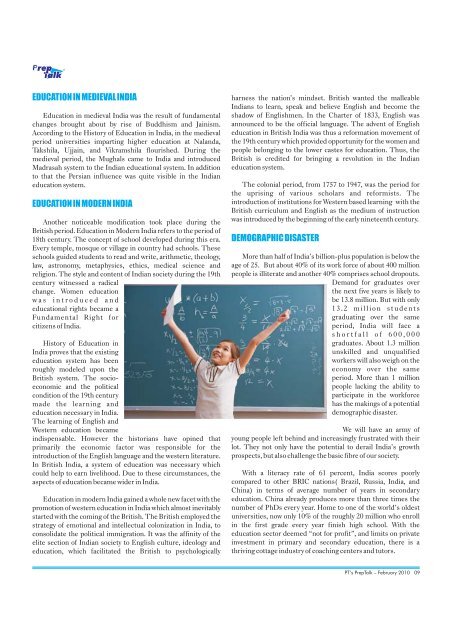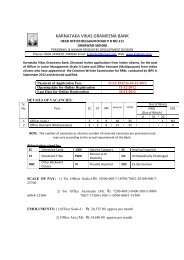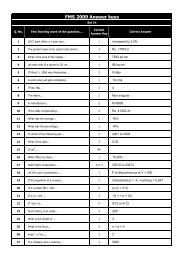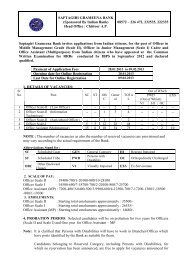Feb 2010_Preptalk new.cdr - Student Resources Centre
Feb 2010_Preptalk new.cdr - Student Resources Centre
Feb 2010_Preptalk new.cdr - Student Resources Centre
Create successful ePaper yourself
Turn your PDF publications into a flip-book with our unique Google optimized e-Paper software.
EDUCATION IN MEDIEVAL INDIAEducation in medieval India was the result of fundamentalchanges brought about by rise of Buddhism and Jainism.According to the History of Education in India, in the medievalperiod universities imparting higher education at Nalanda,Takshila, Ujjain, and Vikramshila flourished. During themedieval period, the Mughals came to India and introducedMadrasah system to the Indian educational system. In additionto that the Persian influence was quite visible in the Indianeducation system.EDUCATION IN MODERN INDIAAnother noticeable modification took place during theBritish period. Education in Modern India refers to the period of18th century. The concept of school developed during this era.Every temple, mosque or village in country had schools. Theseschools guided students to read and write, arithmetic, theology,law, astronomy, metaphysics, ethics, medical science andreligion. The style and content of Indian society during the 19thcentury witnessed a radicalchange. Women educationwas introduced andeducational rights became aFundamental Right forcitizens of India.History of Education inIndia proves that the existingeducation system has beenroughly modeled upon theBritish system. The socioeconomicand the politicalcondition of the 19th centurymade the learning andeducation necessary in India.The learning of English andWestern education becameindispensable. However the historians have opined thatprimarily the economic factor was responsible for theintroduction of the English language and the western literature.In British India, a system of education was necessary whichcould help to earn livelihood. Due to these circumstances, theaspects of education became wider in India.Education in modern India gained a whole <strong>new</strong> facet with thepromotion of western education in India which almost inevitablystarted with the coming of the British. The British employed thestrategy of emotional and intellectual colonization in India, toconsolidate the political immigration. It was the affinity of theelite section of Indian society to English culture, ideology andeducation, which facilitated the British to psychologicallyharness the nation’s mindset. British wanted the malleableIndians to learn, speak and believe English and become theshadow of Englishmen. In the Charter of 1833, English wasannounced to be the official language. The advent of Englisheducation in British India was thus a reformation movement ofthe 19th century which provided opportunity for the women andpeople belonging to the lower castes for education. Thus, theBritish is credited for bringing a revolution in the Indianeducation system.The colonial period, from 1757 to 1947, was the period forthe uprising of various scholars and reformists. Theintroduction of institutions for Western based learning with theBritish curriculum and English as the medium of instructionwas introduced by the beginning of the early nineteenth century.DEMOGRAPHIC DISASTERMore than half of India’s billion-plus population is below theage of 25. But about 40% of its work force of about 400 millionpeople is illiterate and another 40% comprises school dropouts.Demand for graduates overthe next five years is likely tobe 13.8 million. But with only13.2 million studentsgraduating over the sameperiod, India will face ashortfall of 600,000graduates. About 1.3 millionunskilled and unqualifiedworkers will also weigh on theeconomy over the sameperiod. More than 1 millionpeople lacking the ability toparticipate in the workforcehas the makings of a potentialdemographic disaster.We will have an army ofyoung people left behind and increasingly frustrated with theirlot. They not only have the potential to derail India’s growthprospects, but also challenge the basic fibre of our society.With a literacy rate of 61 percent, India scores poorlycompared to other BRIC nations( Brazil, Russia, India, andChina) in terms of average number of years in secondaryeducation. China already produces more than three times thenumber of PhDs every year. Home to one of the world’s oldestuniversities, now only 10% of the roughly 20 million who enrollin the first grade every year finish high school. With theeducation sector deemed “not for profit”, and limits on privateinvestment in primary and secondary education, there is athriving cottage industry of coaching centers and tutors.PT’s PrepTalk – <strong>Feb</strong>ruary <strong>2010</strong> 09
















